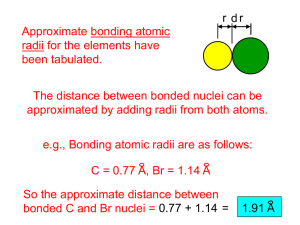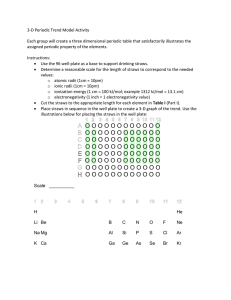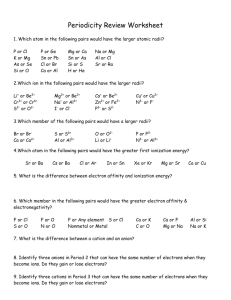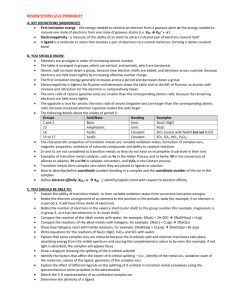r d
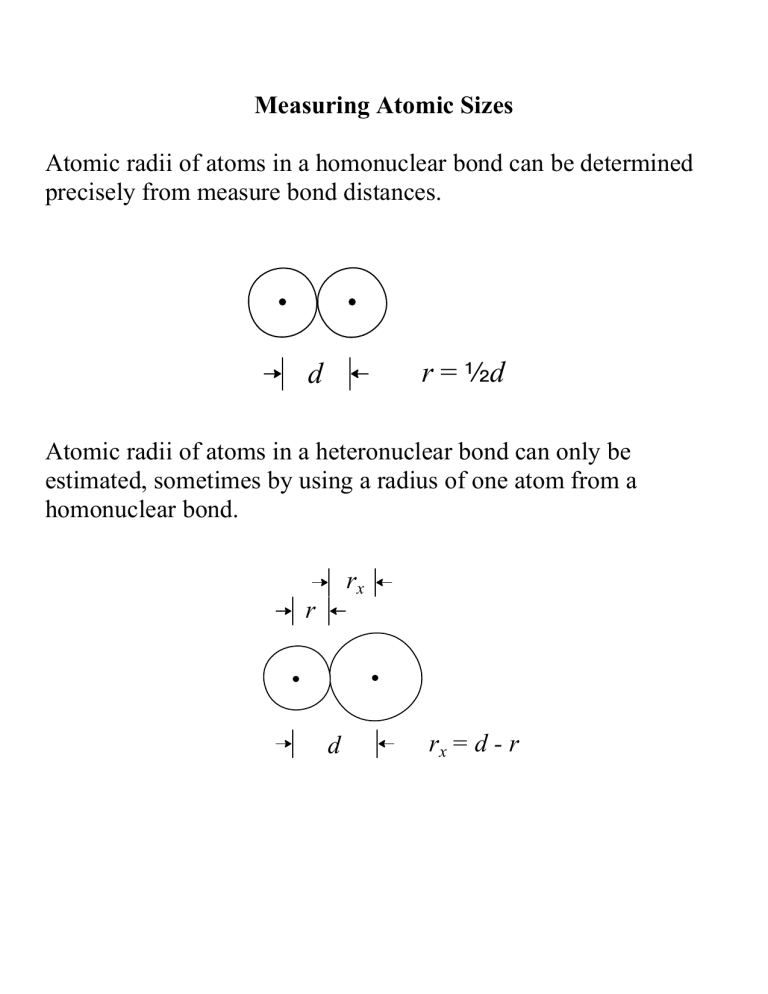
Measuring Atomic Sizes
Atomic radii of atoms in a homonuclear bond can be determined precisely from measure bond distances.
d r = 2 d
Atomic radii of atoms in a heteronuclear bond can only be estimated, sometimes by using a radius of one atom from a homonuclear bond.
r r x d r x
= d - r
Types of Atomic Radii
1.
Covalent radii - Estimates atom's contribution to the length of a typical covalent bond. (This is usually what is meant by
“atomic radii”.)
2.
van der Waals radii - Estimates atom's closest approach to another atom without forming a bond.
3.
Metallic radii - One half the distance between atoms in a metallic element. (Precise.)
Comparison of Covalent and van der Waals Radii of F
2
2 x r
VDW
2 x rcov
Atomic Radii vs. Atomic Number
Periodic Trends in Atomic Radii
P Size increases down a group . The outermost electrons are in successively more extensive orbitals as n increases.
P Size decreases across a period . Electrons are added to the same shell and do not shield one another very effectively from the increasing nuclear charge. This causes all orbitals
(including the outer size-determining orbitals) to contract as Z increases.
P Transition elements contract up to the middle of the series and then expand toward the end.
Shielding becomes more effective after the d subshell is half filled. This makes the size-determining ns electrons move out further towards the end of each series.
P Lanthanides contract slowly across the series.
This results from inefficient shielding by 4 f electrons below the sizedetermining 6 s electrons. The result is called the lanthanide contraction.
Effect of Lanthanide Contraction on
Third-Row Transition Elements
V
122
Nb
134
Ta
134
Cr
117
Mo
129
W
130
Mn
117
Tc
---
Re
128
Fe
116
Ru
124
Os
126
(Radii in picometers, pm.)
P Second-row transition elements are significantly bigger than first-row transition elements in each group, as expected.
P Third-row transition elements are virtually the same sizes as second-row transition elements in each group, due to the intervening lanthanides, which contract slowly across the series.
Ionization Energy
M( g ) 6 M + ( g ) + e ∆ H o / I
L All first and succeeding ionization energies are positive
(endothermic).
Al( g ) 6 Al
Al + ( g ) 6 Al
+ ( g )
Al 2+ ( g ) 6 Al 3+
I
1
= 578 kJ/mol
2+ ( g ) I
2
= 1820 kJ/mol
( g ) I
3 ___________________________________
Al( g ) 6 Al 3+ ( g ) I t
= 5148 kJ/mol
Ionization Energy vs. Atomic Number
Periodic Trends in First Ionization Energies
P Ionization energy decreases down a group.
P Ionization energy tends to increase across a period.
P More energy is required to disrupt a half- or fully-filled shell or subshell, while less is required to achieve such configurations.
U This accounts for the "jogs" in the trends at Be/B and
N/O, for example.
Be (2 s 2 ) 6 Be +
N (2 s 2 2 p 3 ) 6 N +
(2 s 1 )
(2 s 2 2 p 2 )
> B(2 s 2 2 p 1
> O (2 s 2 2 p
) 6 B
4 ) 6 O
+
+
(2 s 2 )
(2 s 2 2 p 3 )
P Ionization energy rises more slowly across transition and inner transition series.
P Ionization energies are lowest in the lower left and highest in the upper right of the periodic table.
Electron Affinity
A( g ) + e 6 A ( g ) ∆ H o / A
L First electron affinities can be negative (exothermic) or positive (endothermic).
A < 0 (exothermic) - atom "wants" electron
A > 0 (endothermic) - atom "doesn't want" electron
L All second and succeeding electron affinities are positive
(endothermic).
O( g ) + e
O – ( g ) + e
– 6 O – ( g )
– 6 O 2– ( g ) A
A
1
= -142 kJ/mol
2
= +844 kJ/mol
O( g ) + 2 e – 6 O 2– ( g ) A t
= +702 kJ/mol
Electron Affinity Data for Representative Elements (kJ/mol)
1A
H
-73
Li
-60
Na
-53
K
-48
Rb
-47
Cs
-45
2A
Be
+100 *
Mg
+30 *
Ca
?
Sr
?
Ba
?
* Estimated value
3A
B
-27
Al
-44
Ga
-30
In
-30
Tl
-30
4A 5A 6A 7A
C
-122
Si
-134
Ge
-120
Sn
-121
Pb
-110
N
+9 *
P
-72
As
-77
Sb
-101
Bi
-110
O
-141
S
-200
Se
-195
Te
-190
Po
-183
F
-328
Cl
-348
Br
-325
I
-295
At
-270
Periodic Trends in Electron Affinity
L Note: Many irregularities and incomplete data. 7
P Electron affinities tend to become more negative across a period.
P Electron affinities tend to become less negative (or positive) down a group.
P Nonmetals tend to have high (negative) electron affinities, and metals tend to have low (slightly negative or positive) electron affinities.
P Noble gases have positive electron affinities.
Trends in Ionic Radii
L Cations are smaller than the atoms from which they are formed, because the electrons are attracted by a larger number of protons in the nucleus.
- e-
Li
152 pm
Li+
68 pm
L Anions are larger than the atoms from which they are formed, because the electrons are attracted by a smaller number of protons in the nucleus.
+ e-
F
71 pm
F-
133 pm
Trends in Ionic Radii
P Ionic radii increase with negative charge and decrease with positive charge.
Compare radii for the following isoelectronic species with the
Ne configuration:
O 2– F – Na + Mg 2+ Al 3+
1.40 1.33 0.97 0.66 0.51
(Values in Å)
Compare the radii for an element in two charges:
Cu + 0.96 Å Cu 2+ 0.69 Å
Trends in Ionic Radii
P Ionic radii increase down a group for ions of the same charge.
Li +
0.60
Na +
0.95
K +
1.33
Rb +
1.48
Cs +
1.69
Be 2+
0.31
Mg 2+
0.65
Ca 2+
0.99
Sr 2+
1.13
Ba 2+
1.35
Al 3+
0.50
Ga 3+
0.62
In 3+
0.81
Tl 3+
0.95
(Values in Å)
O 2–
1.40
S 2–
1.84
Se 2–
1.98
Te 2–
2.21
F –
1.36
Cl –
1.81
Br –
1.95
I –
2.16
Periodic Trends and Chemical Properties
U The chemical behavior of elements is a consequence of their electronic structure.
U Similarities in the behavior of elements in the same group are a result of their having the same kind of valence configuration.
U Differences in behavior among elements in the same group are often a matter of degree, reflecting changes in the attraction between the nucleus and valence electrons (i.e., effective nuclear charge).
Characteristic Ionic Charges
P In many cases, formation of an element’s characteristic ion is endothermic; i.e., energetically unfavorable.
Al(
O( g g ) 6 Al
) + 2 e –
3+ ( g ) + 3 e
6 O 2– ( g )
– I t
= I
1
+ I
2
+ I
3
= +5148 kJ/mol
A t
= A
1
+ A
2
= +702 kJ/mol
P Most elements that form one or more characteristic cations do so because the energy input for making the ion is more than compensated by the energy released in stable compound formation.
U Noble gas and other closed-subshell configurations are favored, because the energy required to achieve either higher or lower charges is not compensated by enough energy output in compound formation.
U Heavier elements in groups 13-15 tend to be more stable with charges two less than the group number, because the lower energy costs of making the ion are better compensated in compound formation, compared to the group characteristic charge.
L Stable ionic charges represent an energetic “sweet spot” between energy costs and energy pay-backs.

